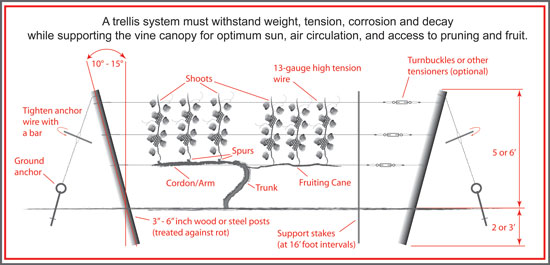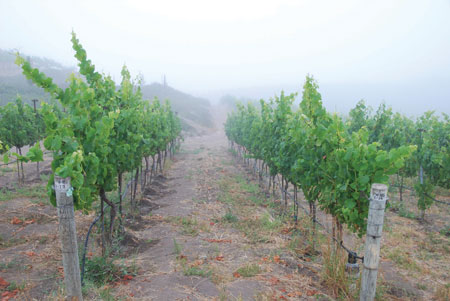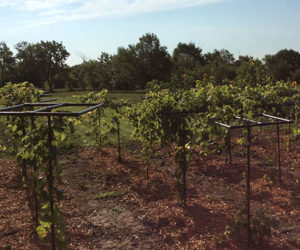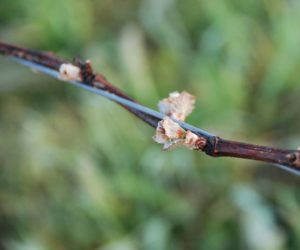In the wild, Vitis vinifera sylvestris (the forest vine that makes wine) cannot support itself as it grows. By understanding the needs of a wild vine, it will quickly become apparent why we need to trellis cultivated grape vines. We’ll also understand how the shape of the trellis will impact vine yield, sun exposure, and ultimately, wine quality.
A wild vine cannot support its own weight, especially when young, and relies on existing structures — namely trees — to climb up. Mature fruit is consumed by birds, who then fly away and drop intact seeds to the ground as waste. A small percentage of these “pre-fertilized” seeds find a moist spot to germinate, often in the shade of a tree or bush, and the vine begins to grow — very slowly for the first few years, then more rapidly after the root system has developed and some leaves on the vine reach direct sunlight.
As the vine comes out of dormancy each spring, it produces growing tips flanked by wiry tendrils that search for structures to wrap around and support the lengthening shoots. Tendrils may find the short boughs of a bush or tree trunk to support the vine. These tendrils will become woody and tough as the vine finishes its yearly growth, keeping the vine permanently affixed to the tree or bush it climbs. A vine may snake along the ground for many years searching out a structure to climb. Without the support it needs to climb vertically, it may perish from predation or never produce fruit.
The vine will continue to climb, in a purely vegetative growing cycle, until there are dormant canes in a position where sunlight activates the dormant buds to become fruitful the next year. This fact will become important later when understanding how fruitfulness in the home vineyard is encouraged. Once the vine is mature and is able to grow into a position where it is parasitizing the host tree’s sunlight, it will “switch on” those sun canes into fruit production. The sun provides energy to convert sunlight into sugar and to make the grapes tasty enough to encourage the birds to consume them.
The use of artificial trellising to produce winegrapes outside of a forest setting (viticulture) began in areas close to the Caucasus Mountains starting in the Neolithic period from about 8000-4500 BC. Unlike these first vineyard mavericks, we have a wide array of materials, designs and hardware to choose from — not to mention thousands of years of science, study and anecdote to draw upon to make wise decisions when designing a trellising system.
Choosing a trellis system for your vineyard is one of the most important planning decisions you will make, second only to picking a varietal and rootstock selection.
Trellising Options
Trellis selection and spacing decisions should be based upon the anticipated vigor of the new vineyard. Vigor can be estimated by examining crops on the same piece of ground or planting a vine or two and seeing how much cane growth you get for a year or two before making trellising decisions.
You can also submit your soil samples to a lab and request a report that will estimate vine vigor.
Styles of Trellising
Trellising systems can be divided into four types:
1. Head-Pruned Vines (each vine trained to a stake)
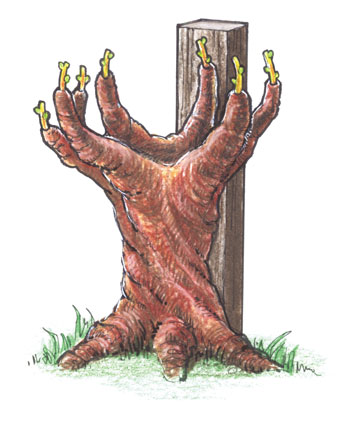
2. Vertical Systems with Shoot Positioning (orients shoot growth up into wires to form a curtain of foliage and a fruit zone that is leaf-pulled for maximum sun and wind exposure)
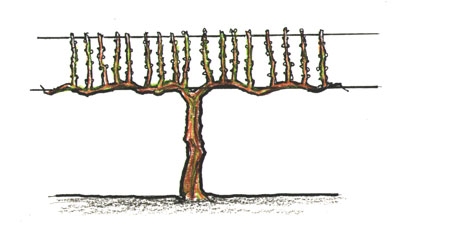
3. “California Sprawl” Systems (without shoot positioning — vines are supported by trellis; all growth spreads out and down with no manipulation)
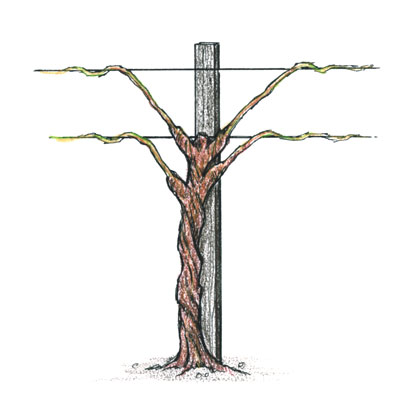
4. Horizontally Divided Systems (with shoot positioning — including Geneva Double Curtain or Lyre systems)
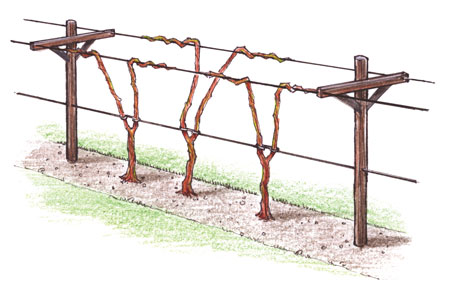
To understand these systems, it’s critical to understand shoot positioning and why it’s important.
Shoot positioning means tucking the growing shoots into sets of shoot positioning wires above the fruiting zone to make the vine rows appear as vertical curtains of foliage that act as vegetative solar panels for grape sugar production. This keeps the shoots from drooping back over the fruiting zone and helps the fruit get better sun and wind penetration. Remember that canes need sunlight, so the idea here is to maximize sun exposure on the shoots and canes.
Head-Trained Vines
Head training vines is the simplest method of vineyard establishment. Head training is not really a trellising method, and most viticulturists have abandoned the system because of problems with shading, rot, mildew and the difficulties inherent in trying to manipulate a vineyard canopy that is not guided by fruiting wires.
To head train a vine, place a training stake next to a newly planted vine and develop a short trunk system, and encourage growth from a low “head” with two-bud spurs retained at pruning. The vine is pruned like a rosebush, with the buds retained forming a goblet shape, with buds facing outward if possible. Canes will grow up and then down, and will likely end up sprawled on the ground and shading the fruit from the outside.
Simple Stake and Wire
A viable choice for low and moderate vigor sites is a simple one, two or three wire system, with or without crossarms. The vines are trained up the stakes, shoots or cordon arms are retained at pruning, and the only support the system provides is for the fruiting canes or cordon arms (on a wire).
Besides the stakes for support and a simple wire for a cordon or fruiting canes, there is nothing else involved. The shoots grow up, out and droop down, shading the fruit zone and making it difficult to get air, sun and spray exposure on the fruit. Stakes should provide at least 3–4’ (0.91–1.2 m) of support, fruiting wires are traditionally about 3–4’ (0.91–1.2 m) off the ground, and no further hardware is required.
Vertical Shoot Positioning
A vertical shoot positioning (VSP) trellis is the gold standard for modern vineyards, and an excellent choice for those who want their vineyard to have that manicured, landscaped look. Depending on the spacing, VSP trellising can be appropriate for all levels of vigor, although moderate to high vigor sites will need to be hedged during the summer — about 6” (15 cm) above the last shoot positioning wires — to keep the canes from drooping back down into the fruit zone.
VSP is appropriate for both cordon trained (permanent arms along the trellis where spurs are retained for fruit production) or cane-pruned systems (where a single cane is retained on each side of the vine and wrapped around a wire and affixed with a twist-tie for fruit production. The hardware necessary is a little more complex, as you will need a wire at 20” (51 cm) or so for irrigation, 30–36” (76–91 cm) for fruiting, and then I suggest a single wire 12” (30 cm) above the fruiting wire (to assist in weaving the growing canes into the catch wires), and then two sets of double wires, spaced 4” (10 cm) or so apart and separated by a vertical 12” (30 cm) where the growing canes are tucked into during the growing season. The pairs of shoot positioning wires can be attached to a wooden cross-arm, a 4–6” (10–15 cm) pinch clip, or they can be simply nailed onto the endposts and attached to wide pre-fab vine stakes that have notches built in.
A well-maintained VSP trellising system allows for unlimited manipulation of the fruiting zone. Because all growth is directed up into the shoot positioning wires, the viticulturist can easily remove leaves and lateral shoots from the fruiting zone, opening it up to sunlight, wind and to allow for better spray penetration. Make sure you allow for enough space between the rows to give a 1:1 ratio of vine height to between-row spacing.
Horizontally Divided Systems
These systems are generally difficult to install and quite difficult to train the vines into, and are generally recommended for high vigor sites and installers and workers that are trained in its use.
At a high vigor site, each vine is separated into two separate canopies to retain a higher number of viable buds at pruning, and to spread the vigor of the vine out to all of the retained buds. This system also maximizes crop yield and allows sunlight to penetrate between the divided canopies, where a single canopy would become overgrown and dense at the same level of vigor. Think of these systems as a single trunk producing two divided canopies, which are traditionally spaced 3–4’ (0.91–1.2 m) apart to allow for sun penetration between them.
Two of the more traditional divided systems include the Geneva Double Curtain (GDC) or the Lyre (sometimes called U-System).
The GDC system requires a stout 48” (1.2 m) stake, with fruiting wires separated 48” (1.2 m) by a crossarm attached to the stake. Four separate healthy shoots are trained to each of the two separated fruiting wires. One shoot trained both directions along each of the wires, which become the permanent cordon arms where spurs are retained at pruning. Pruning is accomplished by retaining only spurs with bud positions facing out into the vine row.
Tips for Choosing A Trellis
By soil samples or by growing a sample vine, determine anticipated vine vigor.
Low Vigor Sites
Low vigor sites can be planted at a relatively tight spacing as the vines will not compete for sunlight, water or nutrients. Rows can be spaced 6–8’ (1.8–2.4 m) and vines spaced 4–6’ (1.2–1.8 m).
VSP, head-trained or sprawl systems would all be appropriate, although VSP is my general recommendation at low-vigor for the ability to manipulate and improve the fruit-zone area of the canopy.
Moderate Vigor Sites
Moderate vigor sites offer many choices for trellising and spacing. Using a low-vigor rootstock may allow for tighter spacing (low-vigor style) and a VSP system. Sprawl or even a divided canopy system may work fine, although the divided systems require more hardware and expert installation and pruning.
Vine spacing can move to the 6–8’ (1.8–2.4 m) range, and match the row spacing to the height of your anticipated canopy height (8–12’/2.4–3.7m).
High Vigor Sites
High vigor sites can still take a VSP system, but it will require a lot of summer hedging, lateral-shoot removal in the fruiting zone, and a vigor-reducing rootstock and careful irrigation choices (dryer soil at the beginning of the growing year will help moderate vigor).
The GDC and Lyre systems are really designed to match high vigor sites, and are generally recommended for those that are willing to do the research and find expert help. Remember that tight vine spacing is NOT recommended for high vigor sites, as vine competition is rarely strong enough to keep high vigor sites in check and will result in an overly-crowded fruiting zone.
Installation
In areas where vineyards are common, you can hire professionals to install your trellis system. If you have a small enough vineyard and like to do things for yourself, you can also build your own trellis. (See the article, “Build Your Own Trellis,” in the April/May 2006 issue of WineMaker.) This requires, however, some specialized tools, especially for tensioning the wires.
If you choose the right trellis system, one that matches the vigor of your vineyard site, you can get your grapes to harness the power of the sun.
